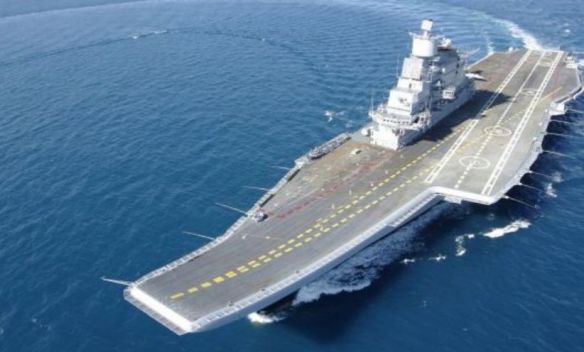The Project 1143.4 Admiral of the Fleet of the Soviet Union, Gorshkov (formerly Baku) was obtained by India and converted, in Russia, to a CTOL aircraft carrier (top), drawing on some of the design work embodied in the Project 1143.5 Admiral of the Fleet of the Soviet Union, Kuznetsov operating with the Russian Federation Navy (above).
A further improvement of the Project 1143, the Project 1143.4, named Baku (later renamed Admiral of the Fleet of the Soviet Union, Gorshkov), was the fourth and last of the Kiev Class, developed under chief designer V.F. Anikiev, and, like her three predecessors, was built at Chernomorsky shipyard where she was laid down on 17 February 1978, launched on 1 April, 1982 and commissioned on 11 December 1987. Although ostensibly referred to as the fourth unit of the Kiev Class, the Baku, which was designed during the period 1979-1980, unlike the Novorossiysk, which had herself introduced a number of improvements over the Kiev and Minsk, was to all intents and purposes a new generation of HACC, featuring an extensive sensor/weapons suite, including enhanced radio-electronic weapons capability and a new design of automated electrical systems documentation was introduced, much of which was a generation ahead of those of her half-sisters – Kiev, Minsk and Novorossiysk.
There were a number of changes to the sensor/electronics suite of the Baku, the most radical being the incorporation of a Mars Passat air/surface search radar complex, an MR-700M enhanced derivative of the MR-700 Fregat air surface search radar, the MR-600 of her predecessors being omitted. A new combat data management system, apparently referred to as the MVU-410 Lesorub-434, replaced the MI-110R system of the other Kiev Class units. There were changes to the sonar suite, although the MGK-355 complex introduced on the Project 1143.3 was apparently retained in the Project 1143.4. There were a number of other changes to the communications systems and additions the fire controls systems for the new generation weapon complex’s equipping the vessel.
The Baku featured an enhanced anti-ship missile capability – the number of launchers for the P-500 ASCM of the Bazalt missile complex being increased from eight to twelve, a factor of 1.5. The M-11 surface to air missile systems were omitted, a vertical launch system for 192 Tor M-1 derivative surface to air missiles being introduced in their stead. This system consisted of four groups each of a six launch tube cell for 9K330 (also referred to as 9M330/1) missiles – two six tube cells located ahead of the forward P-500 battery, another six tube cell located on the starboard deck aft of the island and a fourth six tube cell on the port side on the after part of the ship. Other changes to the weapon suite included the substitution of two single 100 mm gun mounts in place of the two twin 76.2 mm mounts and apparently the substitution of two RBU-12000 ASW rocket launchers for the two RBU-6000 units installed in the Kiev, Minsk and Novorossiysk.
The Project 1143.4 featured a number of other improvements including, as stated in JPSC Nevskoe Design Bureau documentation, increased survivability courtesy of “above water structural protection”. The enhancements came at the price of a slightly reduced air wing of 35 aircraft in comparison to the 36 of the Novorossiysk, although this was still superior to the 32 aircraft air group of the Kiev and Minsk.
While the Kiev Class had a primary SSBN defense role, being major surface combatants, it was inevitable that the Class would form element of various task groups and detached squadrons operating in various distant stations such as the Mediterranean Sea and the Indian Ocean. For instance, a task group centered on a Kiev Class vessel was deployed to the Indian Ocean in 1982, this group also participating in a worldwide Soviet naval exercise that year. In 1983, the Novorossiysk operated with a task group in the Indian Ocean, despite the decline that year, that had continued each year since 1981, of the Soviet presence (in ship days) in that region. In general, despite 1983 being regarded as the peak year of Soviet operations outside home waters (recorded as around 60,000 ship days, a 6% increase on the previous year), there was a decline in such operations by surface combatants, the increase being attributed to increased operations by the general purpose submarine force and amphibious warfare ships. From late 1985, at the commencement of the Admiral Chernarvin era (Chernarvin replaced Gorshkov as commander of the Soviet Navy in 1985), large scale Soviet naval operations began to contract to areas closer to the Soviet homeland in line with the defensive doctrine that was advocated when Gorbachev took office as the Soviet Premier that year, remaining until ousted as a result of a Coup in 1991, the year the Soviet Empire would break-up.
As far as can be ascertained through available documentation all four Kiev Class vessels had been decommissioned by Russia by 1995, although there is a degree of ambiguity. It is clear that Kiev and Minsk were sold to commercial enterprises, ultimately being displayed as Museum exhibits in China, being preserved in this manner in early 2016 at Tianjin and Shenzhen respectively. Novorossiysk was sold for scrap and commenced break-up in 1997 and the Baku (Admiral of the Fleet of the Soviet Union, Gorshkov) was sold to India in 2004, the sale including the modernisation and conversion of the vessel to a conventional take-off and landing) aircraft carrier for operations with MiG-29K/KUB strike fighters and Ka-28/31 helicopters. The ship re-commissioned in her new incarnation as the INS Vikramaditya in 2013.
